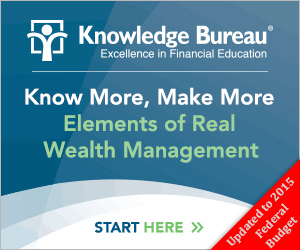Last updated: May 05 2015
Connecting The Dots Isn’t Child’s Play - Elements of Real Wealth Management

There are many unique opportunities to serve clients in the tax and financial services today. More than ever, clients expect to receive advice that is relevant both for today’s environment and for the long-term.
They are looking for a “wealth manager” to connect the dots between the various “silos” of expertise they may be paying for. Above all, Canadians are looking for someone they trust to provide the direction they seek when making important financial decisions for the immediate future.But, in addition, with the introduction of CRM2 in 2016, financial advisors are under more pressure to disclose fees and create unique value propositions to retain clients. Markets are volatile and taxes continue to be the largest single lifetime expense for affluent households. As a result, competent wealth managers are in high demand.
Becoming a trusted advisor in today’s market requires integration of traditional planning processes with income, tax and estate planning. This can be achieved by utilizing key principles through Real Wealth ManagementTM, the process taught in Elements of Real Wealth Management, a newly updated course from Knowledge Bureau.
This program relies on implementing three critical components in your practice:
- Real Wealth Management requires an ongoing focus on the elements of accumulation, growth, preservation and transition of wealth in making decisions about income and capital at each stage of life.
- Creation of Purchasing Power, defined as what you have left after tax, after costs and after inflation, requires a focus on the sustainability of capital in order to fund future lifestyles. What matters is what you keep, rather than what you have. Therefore advisors must focus on strategies to minimize taxes and costs while anticipating the long-term impact of inflation to effectively manage and minimize risk to savings. Truly wealthy people have peace of mind, attainable with a focus on sustainable wealth over time.
- Real Wealth Managers provide fully integrated, multi-generational advice by developing relationships with a multi-disciplinary team of professionals who can work together under one strategic plan toward client goals using three common analysis tools: the Net Worth Statement, the tax return and the financial plan.
This systematic process helps advisors analyze both income and build capital pools. The result is the creation of sustainable wealth in a multi-generational approach that focuses on the accumulation, growth, preservation and transition of wealth on a net, after-tax basis.
By moving beyond the traditional scope of product placement, successful advisors are able to provide the kind of value-added, long-term guidance and leadership clients are looking for, thus creating an environment that distinguishes their practice.
The course was originally written by Evelyn Jacks, newly updated by Murray Leiter.
To learn more about Knowledge Bureau’s Real Wealth Management™ and how to distinguish yourself as a Master Financial Advisor™, click here.

